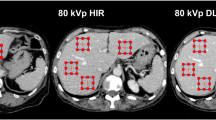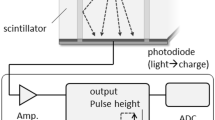Abstract
Objectives
To explore the performance of low-dose computed tomography (LDCT) with deep learning reconstruction (DLR) for the improvement of image quality and assessment of lung parenchyma.
Methods
Sixty patients underwent chest regular-dose CT (RDCT) followed by LDCT during the same examination. RDCT images were reconstructed with hybrid iterative reconstruction (HIR) and LDCT images were reconstructed with HIR and DLR, both using lung algorithm. Radiation exposure was recorded. Image noise, signal-to-noise ratio, and subjective image quality of normal and abnormal CT features were evaluated and compared using the Kruskal–Wallis test with Bonferroni correction.
Results
The effective radiation dose of LDCT was significantly lower than that of RDCT (0.29 ± 0.03 vs 2.05 ± 0.65 mSv, p < 0.001). The mean image noise ± standard deviation was 33.9 ± 4.7, 39.6 ± 4.3, and 31.1 ± 3.2 HU in RDCT, LDCT HIR-Strong, and LDCT DLR-Strong, respectively (p < 0.001). The overall image quality of LDCT DLR-Strong was significantly better than that of LDCT HIR-Strong (p < 0.001) and comparable to that of RDCT (p > 0.05). LDCT DLR-Strong was comparable to RDCT in evaluating solid nodules, increased attenuation, linear opacity, and airway lesions (all p > 0.05). The visualization of subsolid nodules and decreased attenuation was better with DLR than with HIR in LDCT but inferior to RDCT (all p < 0.05).
Conclusion
LDCT DLR can effectively reduce image noise and improve image quality. LDCT DLR provides good performance for evaluating pulmonary lesions, except for subsolid nodules and decreased lung attenuation, compared to RDCT-HIR.
Clinical relevance statement
The study prospectively evaluated the contribution of DLR applied to chest low-dose CT for image quality improvement and lung parenchyma assessment. DLR can be used to reduce radiation dose and keep image quality for several indications.
Key Points
• DLR enables LDCT maintaining image quality even with very low radiation doses.
• Chest LDCT with DLR can be used to evaluate lung parenchymal lesions except for subsolid nodules and decreased lung attenuation.
• Diagnosis of pulmonary emphysema or subsolid nodules may require higher radiation doses.






Similar content being viewed by others
Abbreviations
- AiCE:
-
Advanced Intelligent Clear-IQ Engine
- AIDR 3D:
-
Adaptive Iterative Dose Reduction 3-Dimensional
- AP:
-
Anteroposterior
- BMI:
-
Body mass index
- CT:
-
Computed tomography
- CTDIvol :
-
Volume CT dose index
- DCNN:
-
Deep convolutional neural networks
- DLP:
-
Dose-length product
- DLR:
-
Deep learning reconstruction
- ED:
-
Effective dose
- FBP:
-
Filtered back projection
- GGN:
-
Ground-glass nodule
- HIR:
-
Hybrid iterative reconstruction
- HU:
-
Hounsfield Unit
- LAT:
-
Lateral
- LDCT:
-
Low-dose CT
- MBIR:
-
Model-based iterative reconstruction
- RDCT:
-
Regular-dose CT
- ROI:
-
Regions of interest
- SD:
-
Standard deviation
- SNR:
-
Signal-to-noise ratio
- SSDE:
-
Size-specific dose estimates
- Std:
-
Standard
- Str:
-
Strong
References
Smith-Bindman R, Wang Y, Chu P et al (2019) International variation in radiation dose for computed tomography examinations: prospective cohort study. BMJ 364:k4931
Alsharif W, Qurashi A (2021) Effectiveness of COVID-19 diagnosis and management tools: a review. Radiography (Lond) 27(2):682–687
Kim H, Park CM, Chae HD et al (2015) Impact of radiation dose and iterative reconstruction on pulmonary nodule measurements at chest CT: a phantom study. Diagn Interv Radiol 21(6):459–465
Zhang M, Qi W, Sun Y et al (2018) Screening for lung cancer using sub-millisievert chest CT with iterative reconstruction algorithm: image quality and nodule detectability. Br J Radiol 91(1090):20170658
Ye K, Zhu Q, Li M et al (2019) A feasibility study of pulmonary nodule detection by ultralow-dose CT with adaptive statistical iterative reconstruction-V technique. Eur J Radiol 119:108652
Willemink MJ, Noël PB (2019) The evolution of image reconstruction for CT-from filtered back projection to artificial intelligence. Eur Radiol 29(5):2185–2195
Hata A, Yanagawa M, Yoshida Y et al (2021) The image quality of deep-learning image reconstruction of chest CT images on a mediastinal window setting. Clin Radiol 76(2):155.e15–155.e23
Singh R, Digumarthy SR, Muse VV et al (2020) Image quality and lesion detection on deep learning reconstruction and iterative reconstruction of submillisievert chest and abdominal CT. AJR Am J Roentgenol 214(3):566–573
Kim JH, Yoon HJ, Lee E et al (2021) Validation of deep-learning image reconstruction for low-dose chest computed tomography scan: emphasis on image quality and noise. Korean J Radiol 22(1):131–138
Franck C, Zhang G, Deak P et al (2021) Preserving image texture while reducing radiation dose with a deep learning image reconstruction algorithm in chest CT: a phantom study. Phys Med 81:86–93
Greffier J, Hamard A, Pereira F et al (2020) Image quality and dose reduction opportunity of deep learning image reconstruction algorithm for CT: a phantom study. Eur Radiol 30(7):3951–3959
Svalkvist A, Fagman E, Vikgren J et al (2023) Evaluation of deep-learning image reconstruction for chest CT examinations at two different dose levels. J Appl Clin Med Phys 24(3):e13871
Tian Q, Li X, Li J et al (2022) Image quality improvement in low-dose chest CT with deep learning image reconstruction. J Appl Clin Med Phys 23(12):e13796
Wang H, Li LL, Shang J et al (2022) Application of deep learning image reconstruction in low-dose chest CT scan. Br J Radiol 95(1133):20210380
Aberle DR, Berg CD, Black WC et al (2011) The National Lung Screening Trial: overview and study design. Radiology 258(1):243–253
Kang H (2021) Sample size determination and power analysis using the G*Power software. J Educ Eval Health Prof 18:17
Jiang B, Li N, Shi X et al (2022) Deep learning reconstruction shows better lung nodule detection for ultra-low-dose chest CT. Radiology 303(1):202–212
Pontana F, Billard AS, Duhamel A et al (2016) Effect of iterative reconstruction on the detection of systemic sclerosis-related interstitial lung disease: clinical experience in 55 patients. Radiol 279(1):297–305
Yamada Y, Jinzaki M, Hosokawa T et al (2012) Dose reduction in chest CT: comparison of the adaptive iterative dose reduction 3D, adaptive iterative dose reduction, and filtered back projection reconstruction techniques. Eur J Radiol 81(12):4185–4195
Lee SW, Kim Y, Shim SS et al (2014) Image quality assessment of ultra low-dose chest CT using sinogram-affirmed iterative reconstruction. Eur Radiol 24(4):817–826
Hansell DM, Bankier AA, MacMahon H et al (2008) Fleischner Society: glossary of terms for thoracic imaging. Radiology 246(3):697–722
Deak PD, Smal Y, Kalender WA (2010) Multisection CT protocols: sex- and age-specific conversion factors used to determine effective dose from dose-length product. Radiology 257(1):158–166
Christner JA, Braun NN, Jacobsen MC et al (2012) Size-specific dose estimates for adult patients at CT of the torso. Radiology 265(3):841–847
AAPM Task Group 204 (2011) Size-specific dose estimates (SSDE) in pediatric and adult body CT examinations. Report of AAPM Task Group 204. https://www.aapm.org/pubs/reports/RPT_204.pdf. Accessed 20 May 2021
Sui X, Meinel FG, Song W et al (2016) Detection and size measurements of pulmonary nodules in ultra-low-dose CT with iterative reconstruction compared to low dose CT. Eur J Radiol 85(3):564–570
Christe A, Charimo-Torrente J, Roychoudhury K et al (2013) Accuracy of low-dose computed tomography (CT) for detecting and characterizing the most common CT-patterns of pulmonary disease. Eur J Radiol 82(3):e142–e150
Martini K, Barth BK, Nguyen-Kim TD et al (2016) Evaluation of pulmonary nodules and infection on chest CT with radiation dose equivalent to chest radiography: prospective intra-individual comparison study to standard dose CT. Eur J Radiol 85(2):360–365
Neroladaki A, Botsikas D, Boudabbous S et al (2013) Computed tomography of the chest with model-based iterative reconstruction using a radiation exposure similar to chest X-ray examination: preliminary observations. Eur Radiol 23(2):360–366
de Margerie-Mellon C, de Bazelaire C, Montlahuc C et al (2016) Reducing radiation dose at chest CT: comparison among model-based type iterative reconstruction, hybrid iterative reconstruction, and filtered back projection. Acad Radiol 23(10):1246–1254
Nagatani Y, Takahashi M, Murata K et al (2015) Lung nodule detection performance in five observers on computed tomography (CT) with adaptive iterative dose reduction using three-dimensional processing (AIDR 3D) in a Japanese multicenter study: comparison between ultra-low-dose CT and low-dose CT by receiver-operating characteristic analysis. Eur J Radiol 84(7):1401–1412
Rampinelli C, Origgi D, Vecchi V et al (2015) Ultra-low-dose CT with model-based iterative reconstruction (MBIR): detection of ground-glass nodules in an anthropomorphic phantom study. Radiol Med 120(7):611–617
Xu X, Sui X, Song L et al (2019) Feasibility of low-dose CT with spectral shaping and third-generation iterative reconstruction in evaluating interstitial lung diseases associated with connective tissue disease: an intra-individual comparison study. Eur Radiol 29(9):4529–4537
Meyer E, Labani A, Schaeffer M et al (2019) Wide-volume versus helical acquisition in unenhanced chest CT: prospective intra-patient comparison of diagnostic accuracy and radiation dose in an ultra-low-dose setting. Eur Radiol 29(12):6858–6866
Higaki T, Nakamura Y, Zhou J et al (2020) Deep learning reconstruction at CT: phantom study of the image characteristics. Acad Radiol 27(1):82–87
Baldwin DR, Duffy SW, Wald NJ et al (2011) UK Lung Screen (UKLS) nodule management protocol: modelling of a single screen randomised controlled trial of low-dose CT screening for lung cancer. Thorax 66(4):308–313
Ababneh ZQ, Almusallam M, Alfajri I et al (2021) Estimation of the organ and effective dose to patients undergoing medical diagnostic X-ray examinations in Saudi Arabia. Radiat Prot Dosim 194(1):1–8
Park C, Choo KS, Jung Y et al (2021) CT iterative vs deep learning reconstruction: comparison of noise and sharpness. Eur Radiol 31(5):3156–3164
Azour L, Hu Y, Ko JP et al (2023) Deep learning denoising of low-dose computed tomography chest images: a quantitative and qualitative image analysis. J Comput Assist Tomogr 47(2):212–219
Acknowledgements
We would like to thank Canon Medical Systems for their technical support in this study.
Funding
This study has received funding by the National Natural Science Foundation of China (NSFC No. 82171934); the National Key R&D Program of China (No. 2021ZD0111105); the National High Level Hospital Clinical Research Funding (2022-PUMCH-B-069); the Beijing Municipal Key Clinical Specialty Excellence Program; the Undergraduate Education and Teaching Reform Program of Peking Union Medical College (2021zlgc0112); the CAMS Innovation Fund for Medical Sciences (CIFMS, 2021-I2M-C&T-A-007); and the 2021 SKY Imaging Research Fund of Chinese International Medical Exchange Foundation (No. Z-2014-07-2101).
Author information
Authors and Affiliations
Corresponding authors
Ethics declarations
Guarantor
The scientific guarantor of this publication is Wei Song.
Conflict of interest
The authors of this manuscript declare relationships with the following companies: Zhuangfei Ma and Yinghao Xu are employees of Canon Medical Systems, China, which provided the deep learning reconstruction algorithm used in the study. All remaining authors have declared no conflicts of interest.
Statistics and biometry
No complex statistical methods were necessary for this paper.
Informed consent
Written informed consent was received from each enrolled patient after study process was fully explained.
Ethical approval
Institutional Review Board approval was obtained.
Study subjects or cohort overlap
No study subject or cohort overlap has been reported.
Methodology
-
prospective
-
observational
-
performed at one institution
Additional information
Publisher’s note
Springer Nature remains neutral with regard to jurisdictional claims in published maps and institutional affiliations.
Supplementary Information
ESM 1
(PDF 202 kb)
Rights and permissions
Springer Nature or its licensor (e.g. a society or other partner) holds exclusive rights to this article under a publishing agreement with the author(s) or other rightsholder(s); author self-archiving of the accepted manuscript version of this article is solely governed by the terms of such publishing agreement and applicable law.
About this article
Cite this article
Wang, J., Sui, X., Zhao, R. et al. Value of deep learning reconstruction of chest low-dose CT for image quality improvement and lung parenchyma assessment on lung window. Eur Radiol 34, 1053–1064 (2024). https://doi.org/10.1007/s00330-023-10087-3
Received:
Revised:
Accepted:
Published:
Issue Date:
DOI: https://doi.org/10.1007/s00330-023-10087-3




